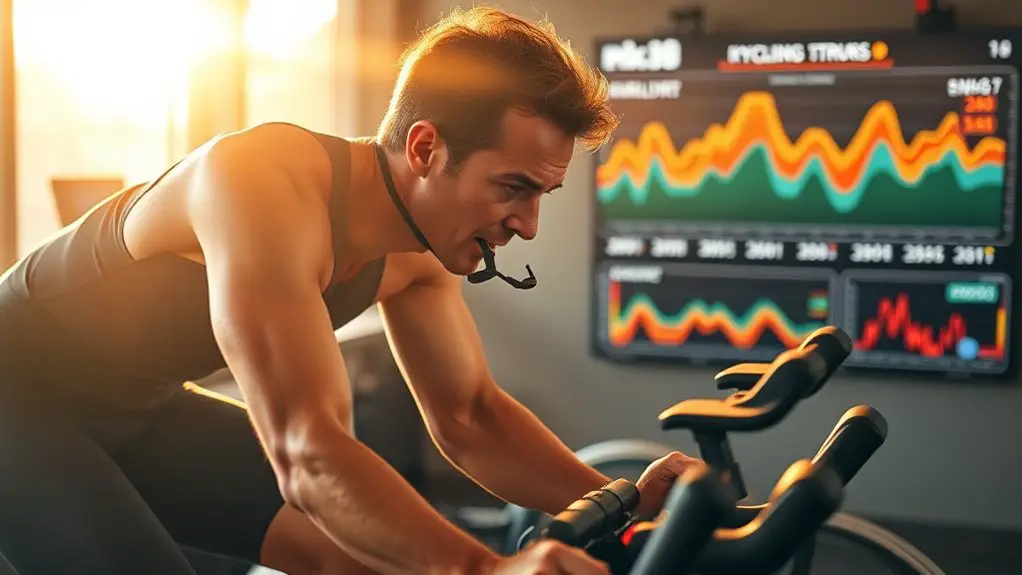To increase your VO2 max for competitive cycling, focus on high-intensity interval training (HIIT) to push your limits and build endurance with longer rides at a consistent pace. Don't forget the importance of smart nutrition; fuel your rides with carbohydrates and stay hydrated. Regularly track your progress to assess what works best for you. By following these strategies, you'll enhance your performance and stamina, and more insights await to help you excel even further.
Understanding VO2 Max and Its Importance in Cycling
VO2 max is a key indicator of your aerobic capacity and overall endurance as a cyclist. Understanding this metric can release the freedom to push your limits and enhance your cycling performance. Higher VO2 max means your body can utilize oxygen more efficiently, which translates into improved stamina on those long rides or steep climbs.
The VO2 max benefits are significant; as you increase this number, you'll notice you can maintain a faster pace for longer periods without fatigue. This not only boosts your confidence but also allows you to explore new routes and challenges without feeling restricted. Incorporating high-intensity interval training into your routine can further elevate your VO2 max and enhance your cycling performance.
Key Factors That Influence VO2 Max
Several factors can considerably influence your VO2 max, impacting your cycling performance. First off, genetic factors play a significant role; your unique DNA can determine your aerobic capacity and the efficiency of your cardiovascular system. You might be blessed with a higher natural VO2 max, giving you an edge in competitive cycling.
Then, there are environmental influences that can't be ignored. Altitude, for instance, can affect your oxygen availability, and training in varied environments can help you adapt, enhancing your performance. Temperature and humidity also come into play, affecting how your body utilizes oxygen during rides.
Lastly, age and gender can impact your VO2 max, with younger individuals typically having higher values. Understanding these elements gives you insight into how to maximize your potential and embrace the freedom of cycling at your best. So, know your body and the world around you to optimize your performance.
Effective Training Techniques to Boost VO2 Max
To effectively increase your VO2 max for competitive cycling, it's crucial to incorporate specific training techniques into your routine. High intensity intervals (HIIT) are a game-changer. These short bursts of maximum effort followed by recovery periods can push your cardiovascular limits and lead to significant improvements in VO2 max. Aim for sessions that last from 20 seconds to 5 minutes, interspersed with active recovery.
Don't forget about endurance workouts, either. Sustained rides at a moderate pace allow your body to adapt and build the aerobic capacity needed for longer races. Try to include longer rides of 60-120 minutes at a steady effort to enhance your endurance base.
Additionally, improved oxygen delivery to muscles during these workouts can greatly enhance your performance. Combining these methods will not only boost your VO2 max but also give you the freedom to tackle varied race conditions head-on. Embrace the challenge, and watch your cycling performance soar!
Nutrition Strategies to Support VO2 Max Improvement
While training hard is essential for increasing your VO2 max, what you eat can greatly impact your performance. To maximize your potential, focus on carbohydrate timing and hydration strategies. Fueling your body correctly before, during, and after rides can lead to improved endurance and recovery. Staying hydrated supports the optimal performance that athletes strive for, ensuring you can push your limits effectively.
Here's a simple guide to help you:
| Time | Food Choices | Hydration Tips |
|---|---|---|
| Pre-ride | Oatmeal, bananas, energy bars | Drink 500ml of water |
| During ride | Sports gels, dried fruits | Sip water or electrolyte every 15-20 mins |
| Post-ride | Protein shake, quinoa salad | Rehydrate with 1L of water |
| Daily intake | Whole grains, lean proteins | Monitor urine color |
Monitoring Progress and Adjusting Your Training Plan
As you endeavor to boost your VO2 max, monitoring your progress is essential for identifying what works and what doesn't in your training plan. Regular progress tracking helps you understand how your body responds to various workouts, allowing you to fine-tune your approach. Consider using tools like heart rate monitors or performance apps to keep an eye on key metrics.
Once you've gathered data, don't hesitate to make training adjustments. If a particular workout isn't yielding results, switch it up! Incorporate intervals, increase intensity, or adjust your recovery periods. Embrace the freedom of experimentation—every cyclist's journey is unique.
Stay flexible and responsive to your body's needs, and don't be afraid to tweak your training plan based on the insights you gain. By consistently monitoring and adjusting your approach, you'll be on a path to greater endurance and performance, ultimately raising your VO2 max for competitive cycling.
Frequently Asked Questions
Can Age Affect My VO2 Max Levels?
Yes, age can affect your VO2 max levels. As you get older, age-related changes like decreased muscle mass and lung function can lead to a decline in your aerobic capacity. However, don't let that discourage you! With consistent training adaptations, you can still improve your fitness. Embracing a tailored exercise routine can help you maintain and even boost your VO2 max, giving you the freedom to stay active and competitive at any age.
What Role Does Genetics Play in VO2 Max?
Genetics plays a significant role in your VO2 max, influencing your genetic predisposition to aerobic capacity. This means some folks naturally have higher levels than others. VO2 max variability can be quite pronounced, depending on your family history and background. While you can't change your genes, understanding their impact can empower you to maximize your potential through training and lifestyle choices, allowing you the freedom to push your limits in fitness.
How Often Should I Test My VO2 Max?
You should test your VO2 max regularly to track your progress, typically every 4 to 6 weeks. This testing frequency allows you to see improvements and adjust your training accordingly. A VO2 assessment can reveal how your fitness is evolving, giving you the freedom to optimize your workouts. Just remember, it's crucial to listen to your body and guarantee you're recovering properly between tests to get the most accurate results.
Are There Specific Recovery Strategies for VO2 Max Training?
When it comes to recovery strategies for VO2 max training, you'll want to focus on a few key areas. Incorporate active recovery sessions to keep your body loose. Don't forget about nutrition strategies; fueling your body right is essential. Make sure you're taking rest days to let your muscles repair. Finally, stay on top of your hydration practices to maintain peak performance. Balancing these elements will help you feel free and ready for your next workout!
Is There a Difference Between VO2 Max and Lactate Threshold?
Yes, there's definitely a difference between VO2 max and lactate threshold. VO2 max testing measures the maximum amount of oxygen your body can utilize during intense exercise, while lactate threshold training focuses on the point where lactic acid builds up in your muscles, causing fatigue. Understanding both can help you optimize your performance, giving you more freedom to push your limits and improve your endurance in any athletic pursuit you choose.




